The beaches, estuaries, and waters of North Carolina are popular destinations for tourists and locals alike. But, North Carolina waters are no stranger to sharks. Some of the biggest sharks near North Carolina beaches are also some of the most magnificent and dangerous.
There were 3 confirmed shark attacks in North Carolina last year. The last fatal attack in North Carolina occurred in 2001 – before that, there had been no fatal shark attacks in North Carolina since 1957. How big are the sharks near North Carolina? Let’s take a closer look at the ten biggest sharks near North Carolina beaches!

10. Sandbar Shark
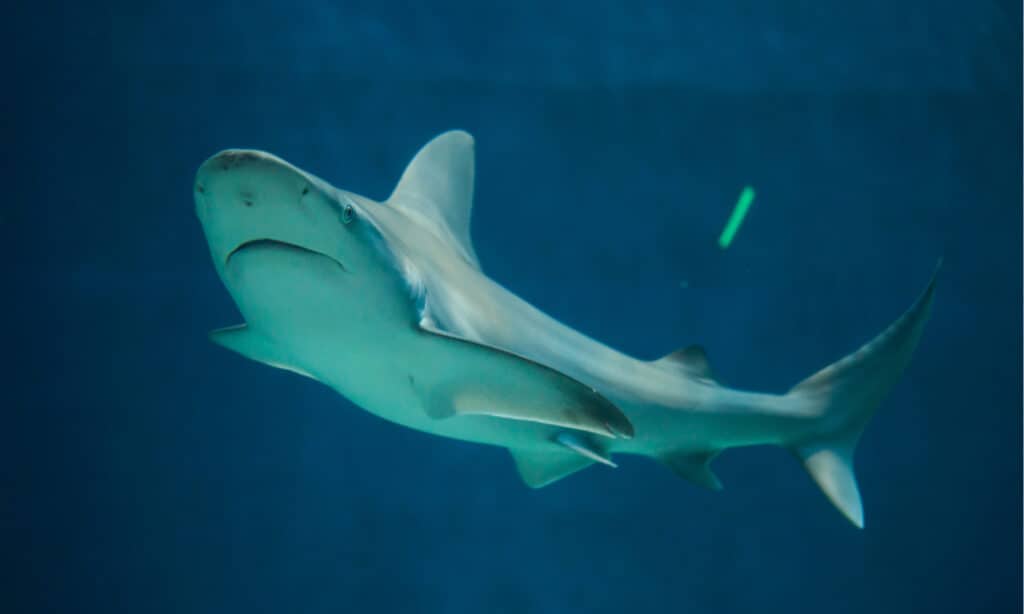
Sandbar sharks frequent the oceanic waters of North Carolina.
©Vladimir Wrangel/Shutterstock.com
Sandbar sharks near North Carolina beaches are common. They grow up to eight feet long and may be seen in Pamlico Sound. They’re light gray to brown, with very tall dorsal fins. Sandbar sharks are endangered, largely due to overfishing and pollution. These sharks live in warm coastal waters in tropical and subtropical zones.
9. Blacktip Shark
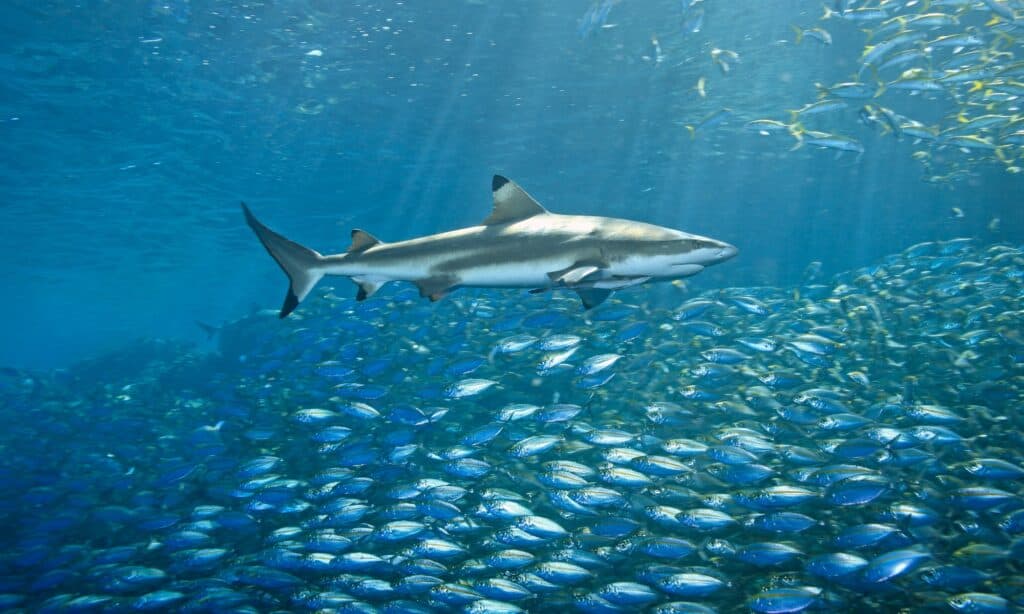
The blacktip shark is a popular target for sport fishers, despite their status as vulnerable to extinction.
©iStock.com/cbpix
Blacktip sharks grow up to eight feet long, and feed on schooling fish, like mullet and menhaden. They’re known to swim both in the estuaries and open ocean waters of North Carolina. Blacktip sharks get their name from the black tips of their fins. They’re not aggressive, though bites on humans do occur, especially when people, blacktips, and fish occupy the same waters. These sharks have thin, pointed teeth designed to catch fish.
8. Spinner Shark
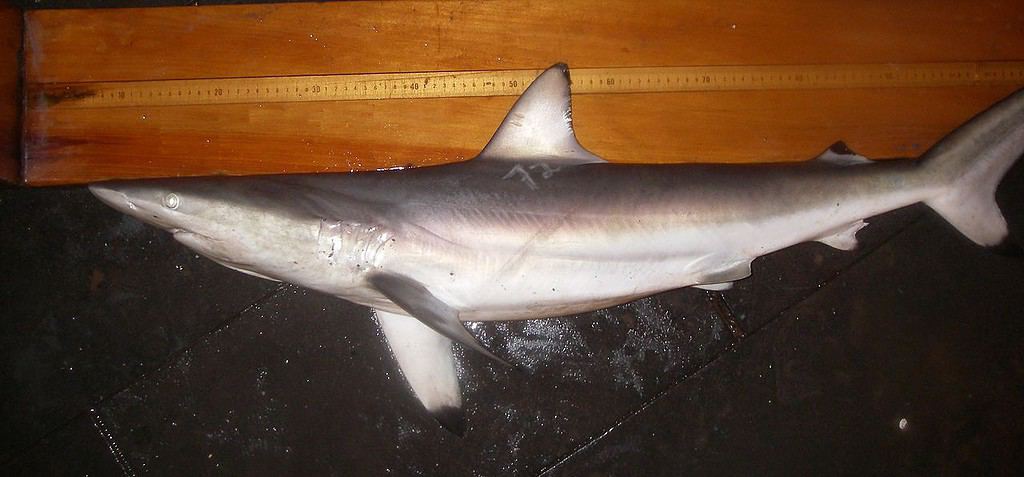
Spinner sharks
are very similar to blacktip sharks, they’re often mistaken for one another.
©SEFSC Pascagoula Laboratory; Collection of Brandi Noble, NOAA/NMFS/SEFSC / public domain – License
Spinner sharks are some of the biggest sharks near North Carolina beaches; they grow up to 9 feet long. They get their name from the way they seem to spin while hunting – these sharks have even been known to jump clear out of the water after fish. They’re currently vulnerable to extinction due to overfishing and pollution. Spinner sharks rarely travel into North Carolina’s estuaries or sounds, but do swim along the coast. They eat lizardfish, bluefish, stingrays, bonio, jacks, and other kinds of fish.
7. Sand Tiger Shark
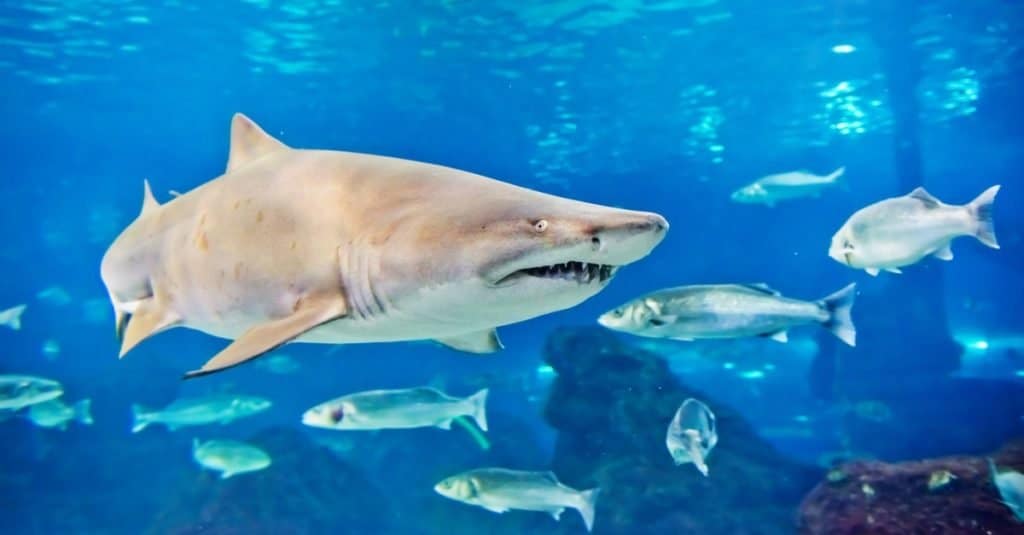
Despite their huge size and fearsome appearance, sand
tiger
sharks rarely attack humans.
©Valeri Potapova/Shutterstock.com
Sand tiger sharks grow up to 10.5 feet long. They’re particularly common near wrecks off the North Carolina coast. They’re some of the biggest sharks near North Carolina beaches. Sand tiger sharks are also known as blue nurse sand tiger sharks, spotted ragged-tooth sharks, and grey nurse sharks. They’re critically endangered and live only in shallow, coastal waters.
6. Bull Shark
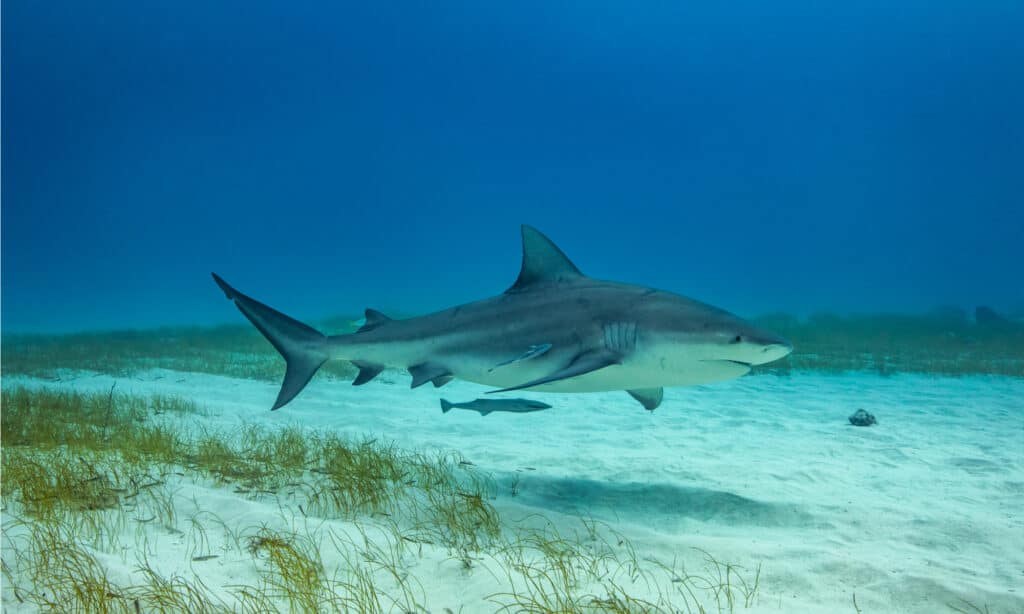
Along with tiger sharks and great white sharks, bull sharks are among the top species in terms of attacks on humans.
©Carlos Grillo/Shutterstock.com
Bull sharks can grow up to 11 feet long, and have streamlined bodies designed for hunting. Like all sharks, they’re apex predators and keystone species. Bull sharks are the only type of shark that can swim upriver into freshwater. They’re commonly found in the Pamlico, Neuse, and Newport Rivers of North Carolina. They eat large fish and even dolphins.
5. Dusky Shark
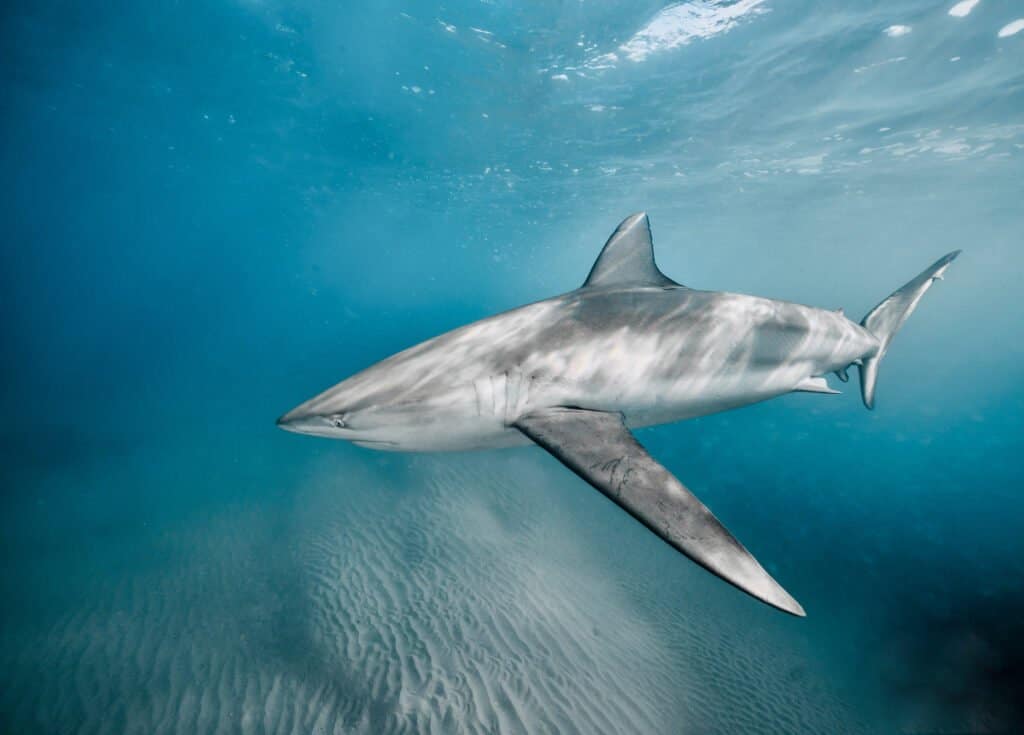
Dusky sharks grow to huge lengths; they’re nearly four feet long at birth.
©sirtravelalot/Shutterstock.com
Dusky sharks grow to 12 feet long and inhabit the oceanic waters off North Carolina’s coast. Like most sharks, their population has declined drastically in the past few decades due to overfishing and pollution. Dusky sharks are migratory, spending their summers farther north, and their winters farther south. They’re endangered and live in shallow coastal waters all over the world. These sharks only rarely attack people.
4. Scalloped Hammerhead

Though fearsome in appearance,
hammerhead sharks
have never been responsible for a human fatality.
©Ian Scott/Shutterstock.com
Once common, scalloped hammerhead sharks near North Carolina beaches have almost entirely been wiped out by overfishing and pollution. Scalloped hammerheads get their name from the curved, irregular appearance of their hammer, also known as a cephalofoil. These sharks grow up to 14 feet long and are critically endangered and absent from many of their former waters.
3. Thresher Shark
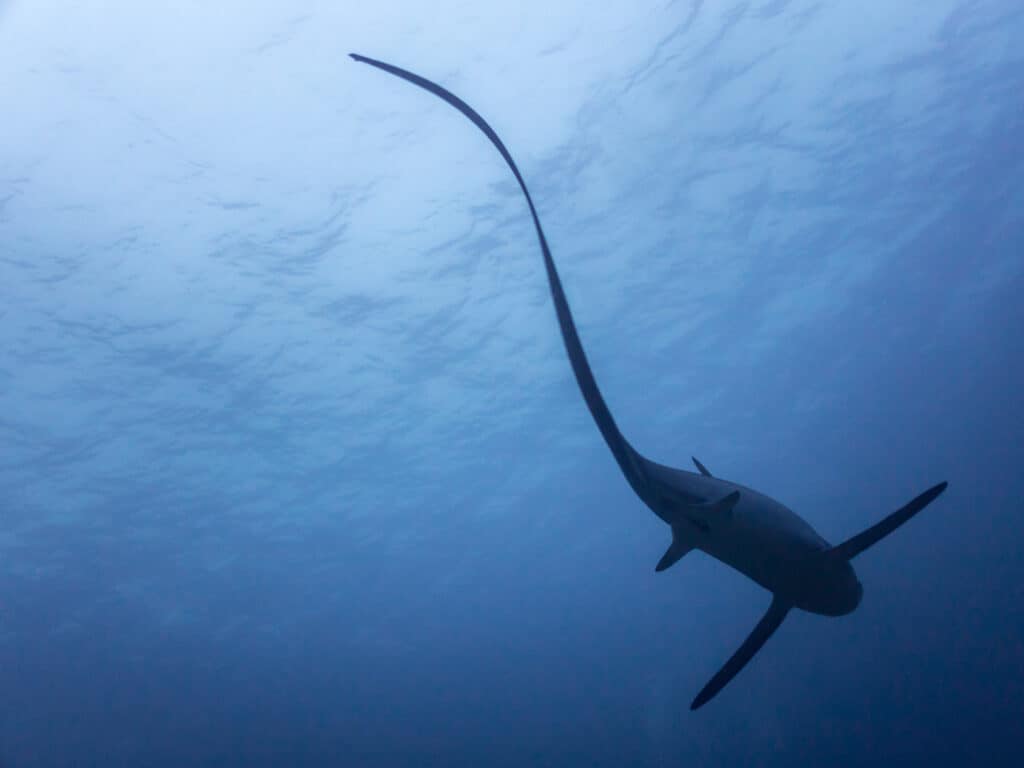
These sharks get their name from their incredibly long tails, which can be up to half of their overall length.
©HikeAndShoot/Shutterstock.com
Thresher sharks near North Carolina beaches reach lengths of up to 20 feet long (believe it or not, but the longest thresher shark on record was 24.9 feet long!). They’re not common to the waters of North Carolina, though they occasionally show up in the coastal oceanic waters, especially in the winter and spring. Thresher sharks hunt by stunning fish with their exceptionally long tails, then consuming them as they lay inert. Despite their size, they rarely attack humans. Thresher sharks are vulnerable to extinction due to overfishing for the shark fin soup industry, sport fishing, bycatch death, and pollution.
2. Tiger Shark

One of the most infamous sharks in the ocean, the
tiger shark
gets its name from the tiger-like stripes on its sides.
©le bouil baptiste/Shutterstock.com
Tiger sharks grow up to a whopping 18 feet long. They’re generally seen far from North Carolina’s shore but occasionally come in closer searching for fish. Tiger sharks eat large fish, other sharks, dolphins, sea turtles, and even human garbage. They typically inhabit tropical and subtropical waters and hunt mostly at night. Tiger sharks have short dorsal fins and squarish, blunt noses. Their teeth are curved to one side and have two serrated edges. Like all sharks, tiger shark populations have declined significantly in recent decades due to overfishing.
1. Great White Shark
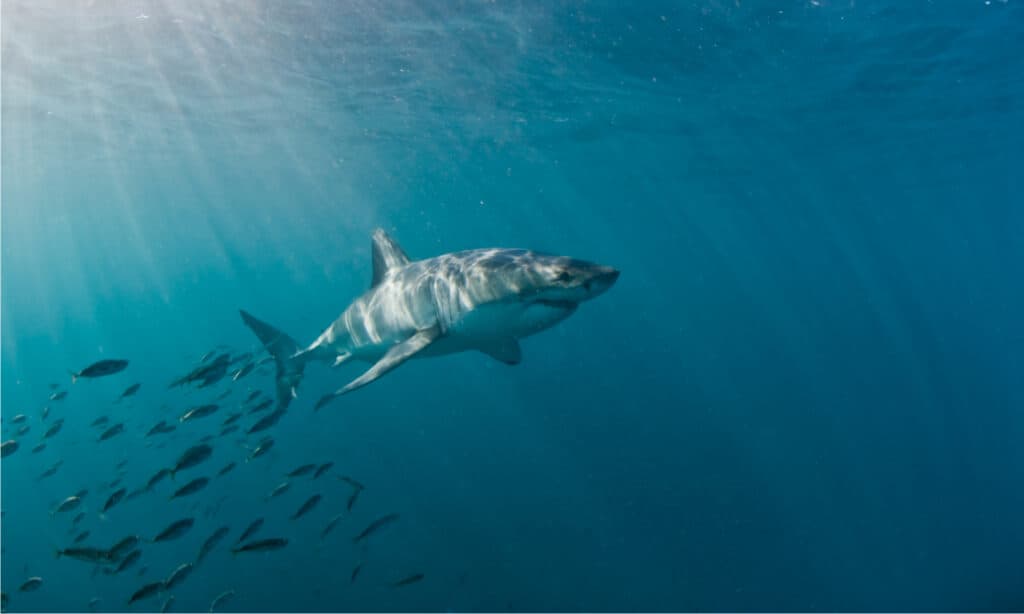
Perhaps the most notorious shark of all, the
great white shark
frequents the waters of the Atlantic Coast.
©Fiona Ayerst/Shutterstock.com
Great white sharks near North Carolina beaches reach lengths of up to 20 feet long. They can be recognized by their large torpedo-like frames, blunt-tipped snouts, dark ventral surfaces, and light ventral surfaces. They’re not found in the estuaries and sounds, but rather swimming in the open ocean. Juvenile great whites stick close to shore, while adults hunt in the deep ocean waters. Great whites have been tracked swimming in the waters near North Carolina’s beaches, but attacks on humans are extremely rare. Great whites eat large fish, dolphins, seals, sea lions, and sea turtles.
Summary of the 10 Biggest Sharks Near North Carolina Beaches
| Rank | Shark Species | Length | Key Features |
|---|---|---|---|
| 1 | Great White Shark | Up to 20 feet | Large, torpedo-like frame, a blunt-tipped snout, a dark dorsal surface, and a pale ventral surface |
| 2 | Tiger Shark | Up to 18 feet | A short dorsal fin and a squarish, blunt nose. |
| 3 | Thresher Shark | Up to 20 feet | An impressively long tail, a darker upper surface in blue, brown, gray, or purple, and a lighter ventral surface. |
| 4 | Scalloped Hammerhead | Up to 14 feet | A curved, irregular hammer or cephalofoil |
| 5 | Dusky Shark | Up to 12 feet | Gray or brown dorsal surface, white ventral surface, and a faint lateral stripe |
| 6 | Bull Shark | Up to 11 feet | Gray dorsal surface, white ventral surface, and a snub snout |
| 7 | Sand Tiger Shark | Up to 10.5 feet | Gray-brown coloring with sparse, light brown spots. Their snouts are also somewhat flat and are also similar to cones in shape. |
| 8 | Spinner Shark | Up to 9 feet | Slender frame, long snout |
| 9 | Blacktip Shark | Up to 8 feet | Black-tipped fins, thin, pointed teeth |
| 10 | Sandbar Shark | Up to 8 feet | Light gray to brown, with very tall dorsal fins |
The photo featured at the top of this post is © Alessandro De Maddalena/Shutterstock.com
Thank you for reading! Have some feedback for us? Contact the AZ Animals editorial team.






